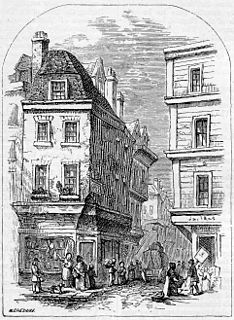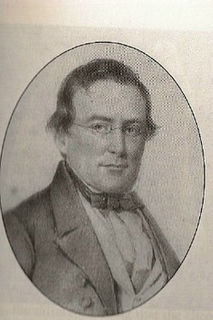Related Research Articles
Junius was the pseudonym of a writer who contributed a series of letters to the Public Advertiser, from 21 January 1769 to 21 January 1772. The signature had been already used, apparently by him, in a letter of 21 November 1768. These and numerous other personal letters were not included in his Letters of Junius collection, published in 1772.
Henry Sampson Woodfall was an English printer and journalist. He was born and lived in London.

William Henry Giles Kingston, often credited as W. H. G. Kingston, was an English writer of boys' adventure novels.

Until the early 19th century, Grub Street was a street close to London's impoverished Moorfields district that ran from Fore Street east of St Giles-without-Cripplegate north to Chiswell Street. It was pierced along its length with narrow entrances to alleys and courts, many of which retained the names of early signboards. Its bohemian society was set amidst the impoverished neighbourhood's low-rent dosshouses, brothels and coffeehouses.

Benjamin Franklin Bache was an American journalist, printer and publisher. He founded the Philadelphia Aurora, a newspaper that supported Jeffersonian philosophy. He frequently attacked the Federalist political leaders, including Presidents George Washington and John Adams, and historian Gordon S. Wood wrote that "no editor did more to politicize the press in the 1790s." His paper's heated attacks are thought to have contributed to passage of the Alien and Sedition Acts by the 5th United States Congress and signed by President John Adams in 1798.
Henry Colburn was a British publisher.
John Holt (1721—1784) was a colonial American newspaper publisher, printer, postmaster, and mayor of Williamsburg, Virginia, United States. He was involved with publishing the Connecticut Gazette, the New York Gazette, and the New-York Journal newspapers. He worked with Benjamin Franklin, the prominent publisher James Parker, and Founding Father Samuel Adams. He had a store that sold miscellaneous supplies, ink, paper, and books on a variety of subjects including religion, freemasonry, economics, history, archaeology, poetry, and biographies.
Horace Henry Hart was an English printer and biographer. He was the author of Hart's Rules for Compositors and Readers, first issued in 1893.
The Morning Chronicle was a newspaper founded in 1769 in London. It was notable for having been the first steady employer of essayist William Hazlitt as a political reporter and the first steady employer of Charles Dickens as a journalist. It was the first newspaper to employ a salaried woman journalist Eliza Lynn Linton; for publishing the articles by Henry Mayhew that were collected and published in book format in 1851 as London Labour and the London Poor; and for publishing other major writers, such as John Stuart Mill.
Junius was the pseudonym of a writer who contributed a series of political letters critical of the government of King George III to the Public Advertiser, from 21 January 1769 to 21 January 1772 as well as several other London newspapers such as the London Evening Post.
Letters of Junius is a collection of private and open letters critical of the government of King George III from an anonymous polemicist (Junius) claimed by some to be Philip Francis, as well as other letters in-reply from people to whom Junius had written between 1769 and 1772. The collection was published in two volumes in 1772 by Henry Sampson Woodfall, the owner and editor of a London newspaper, the Public Advertiser.

The Register, originally the South Australian Gazette and Colonial Register, and later South Australian Register, was South Australia's first newspaper. It was first published in London in June 1836, moved to Adelaide in 1837, and folded into The Advertiser almost a century later in February 1931.

The Gazette of the United States was an early American newspaper, first issued semiweekly in New York on April 15, 1789, but moving the next year to Philadelphia when the nation's capital moved there the next year. It was friendly to the Federalist Party. Its founder, John Fenno, intended it to unify the country under its new government. As the leading Federalist newspaper of its time, it praised the Washington and Adams administrations and their policies. Its Federalist sponsors, chiefly Alexander Hamilton, granted it substantial funding; because some of it was directly from the government, the Gazette is considered to have been semi-official. The influence of the newspaper inspired the creation of the National Gazette and the Philadelphia Aurora, rival newspapers for the Democratic-Republicans.

William Woodfall was an English printer, publisher and Parliamentary reporter in the 18th century.

Sampson Low was a bookseller and publisher in London in the 19th century.
The Edinburgh Advertiser, sometimes referred to as The Advertiser, was a twice-weekly newspaper published in Edinburgh, Scotland, on Tuesday and Friday mornings for almost a century, from 1764 to 1859.

Joseph Woodfall Ebsworth (1824–1908) was an English clergyman, known as an editor of ballads, poet and artist.
Thomas Bensley (1759–1835) was an English printer known for fine work, and as a collaborator of Friedrich Koenig. He was an innovator in the fields of steam-powered printing presses, and lithography for book illustration.
George Woodfall (1767–1844) was an English printer.
Samuel Loudon (1727–1813) was a colonial American printer, publisher and merchant who emigrated from Ireland some time prior to 1753. Loudon founded The New-York Packet and The American Advertiser and became the postmaster at New York State's first post office in Fishkill, New York. During the American Revolution he became the official printer of New York State and printed its first Constitution, laws, acts and other official documents, while also taking on some private commissions. Before and during the Revolution Loudon became active through the use of his newspapers promoting the cause for American independence, and for freedom of the press. After the war Loudon printed the Laws of the City of New York, and later promoted ratification of the proposed Constitution by publishing selected essays of The Federalist Papers in his newspaper.
References
- From Grub Street to Fleet Street: An Illustrated History of English Newspapers to 1899 by Bob Clarke, Ashgate Press, 2005